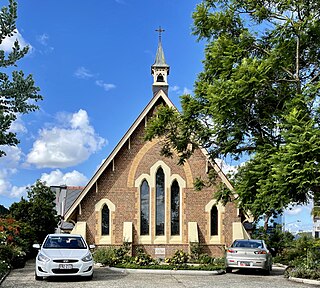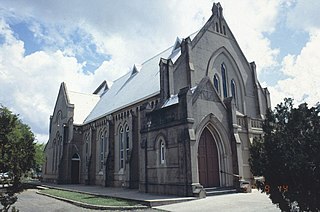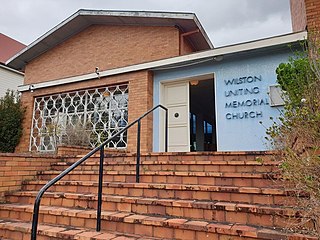
Toowong is a riverside suburb in the City of Brisbane, Queensland, Australia. In the 2021 census, Toowong had a population of 12,556 people. It is predominantly a middle-class area (67.8%), with a median weekly household income of $1,930.

Highgate Hill is a riverside inner southern suburb of the City of Brisbane, Queensland, Australia. In the 2016 census, Highgate Hill had a population of 6,194 people.
James Birrell (1928-2019) was an architect responsible for the design of significant buildings in Queensland, Australia. James Birrell practiced from 1951 to 1986.

St Andrew's Uniting Church is a heritage-listed Uniting church at 131 Creek Street, Brisbane CBD, City of Brisbane, Queensland, Australia. It was designed by George David Payne and built in 1905 by Alexander Lind & Son. Initially St Andrew's Presbyterian Church, it became part of the Uniting Church following the merger of the Presbyterian, Methodist and Congregational Churches in 1977. It was added to the Queensland Heritage Register on 21 October 1992.

Ithaca Presbyterian Church is a heritage-listed church, located at 100 Enoggera Terrace, in the inner city suburb of Paddington, Brisbane, Queensland, Australia. The land was purchased in 1919 by the New Building Fund Committee of the Presbyterian Church, who collected £8000 for the church's construction. The design was commissioned to leading architectural firm Wilson Architects, who were renowned members of Brisbane's Presbyterian community. Construction commenced in 1927 and the building was formally dedicated and opened on Saturday February 9, 1929.
Alexander Brown Wilson was an architect in Queensland, Australia. A number of his works are listed on the Queensland Heritage Register.

Karl Langer (1903–1969) was an Austrian-born architect in Queensland, Australia. A number of his works are listed on the Queensland Heritage Register.

The Church of Saint Ignatius Loyola is a heritage-listed Roman Catholic church at 46 Grove Street, Toowong, City of Brisbane, Queensland, Australia. It was designed by architect Jack Hennessy, junior, and built from 1929 to 1936 by Concrete Construction (QLD) Limited. It was added to the Queensland Heritage Register on 12 July 2005.

St Thomas' Anglican Church is a heritage-listed church at 69 High Street, Toowong, City of Brisbane, Queensland, Australia. It was designed by Francis Drummond Greville Stanley and built in 1877 by Henry Pears. It was also known as St Thomas' Church of England. It was added to the Queensland Heritage Register on 21 October 1992.

John Francis (Jack) Hennessy (1887–1955) was an Australian architect, with the same name as his architect father, John Francis Hennessy, with whom he was in partnership as Hennessy & Hennessy from 1912 to 1924. As principal of the firm after his father retired from 1924 to 1955, he was responsible for many major Art Deco office buildings in capital cities in Australia and New Zealand in the 1930s, as well as many projects for the Catholic Church in Queensland, and the Great Court of the University of Queensland.

Cliffside Apartments is a heritage-listed apartment block at 76 Lower River Terrace, Kangaroo Point, City of Brisbane, Queensland, Australia. It was built from 1936 to 1937. It is also known as Cliffiside Flats. It was added to the Queensland Heritage Register on 27 February 2004.
Hennessy & Hennessy was an architectural firm established in 1912 in Sydney, Australia that was responsible for a series of large scale office buildings in the 1930s in all capital cities in Australia, as well as New Zealand and South Africa, designed by John (Jack) Hennessy (1887–1955), described as Australia's first international architect.

St John's Lutheran Church is a heritage-listed church at 30 George Street, Bundaberg South, Bundaberg, Bundaberg Region, Queensland, Australia. It was designed by Karl Langer and built in 1960 by J Hutchinson and Sons. It was added to the Queensland Heritage Register on 7 December 2012.

St Andrew's Presbyterian Church is a heritage-listed former Presbyterian church at 280 Bolsover Street, in the central business district of Rockhampton, Rockhampton Region, Queensland, Australia. The former church was designed by Voller & Graham in the Gothic Revival style and built from 1893 to 1926. The former church was added to the Queensland Heritage Register on 21 October 1992.

St Paul's Anglican Church is a heritage-listed church at 8 Main Street, Proserpine, Whitsunday Region, Queensland, Australia. It was designed by Eddie Oribin and built from 1958 to 1959 by Les Tinsley & Co. It is also known as St Paul's Anglican Memorial Church and Proserpine Church of England. It was added to the Queensland Heritage Register on 11 October 2013.

Ronald Martin Wilson (1886–1967) was an architect and engineer in Brisbane, Queensland, Australia. A number of his works are heritage-listed.
Peter Newell (1916–2010) was an Australian architect, who worked in the modernist tradition in Queensland and became an architectural critic.
Vitaly de Gzell (1908-1977) was a Russian-Australian architect, who practised in Queensland in the modernist tradition.

Ashgrove Uniting Church is a heritage-listed former church at 24-30 Ashgrove Avenue, Ashgrove, City of Brisbane, Queensland, Australia. Established in 1962 as the Ashgrove Methodist Church, the church is also known as The Grove Uniting Church. It was designed by James Gibson of Cross and Bain. It was added to the Queensland Heritage Register on 25 June 2021.

Wilston Methodist Memorial Church is a heritage-listed former church at 181 Kedron Brook Road, Wilston, Queensland, Australia. It was designed by Ford, Hutton & Newell and built in 1956. It is also known as Trinity Grove Uniting Church, Trinity-Wilston Memorial Uniting Church, Wilston Uniting Church, and Wilston Methodist Church. It was added to the Queensland Heritage Register on 12 November 2021.
















